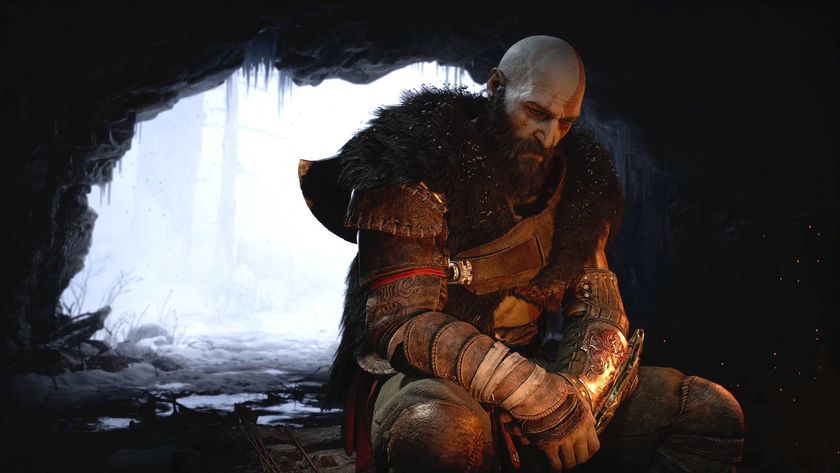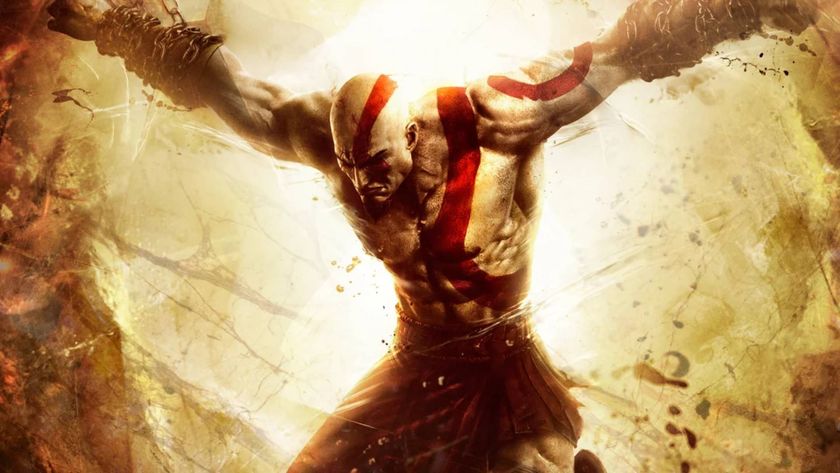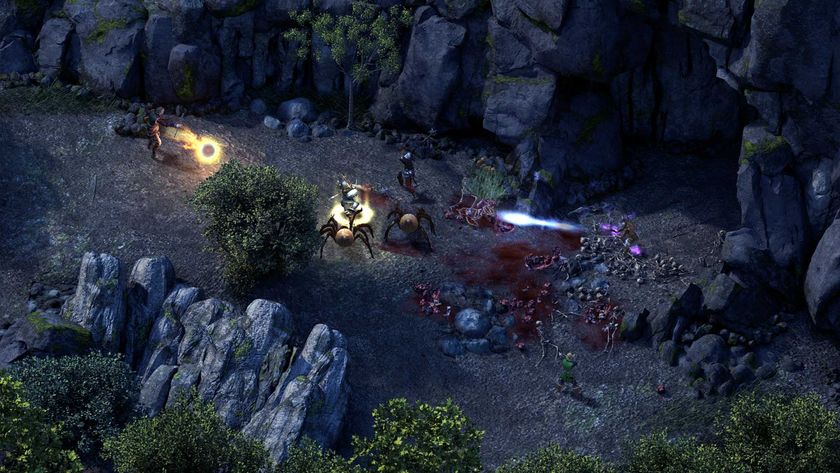12DOVE Verdict
Pros
- +
Quick
- +
fluid combat is more fun than ever
- +
Gigantic sense of scale
- +
Puzzles are clever and challenging
- +
but not that difficult
Cons
- -
QTEs can catch you off-guard
- -
Ending is somehow too long AND too abrupt
- -
Only two Titan levels?
Why you can trust 12DOVE
Kratos isn’t charming. He’s not interested in saving the world, rescuing a princess or really doing anything at all that doesn’t serve his immediate goals of getting revenge and tearing apart anyone that stands in his way. He’s a one-note character with a one-note aspiration, and yet somehow this bald, grunting terror of ancient Greece is the headliner of the PS3’s longest-awaited and most hotly anticipated action game. Although if you’ve followed his exploitssince 2005’s incredible slashfest God of War, you already know why.

God of War III is Kratos’s fifth and ostensibly final adventure, and it brings the series crashing to a fittingly brutal close, giving fans everything they’ve come to expect on a bigger scale than it’s ever been delivered. Gallons of blood are spilled, gods and Titans die in horrifyingly elaborate ways, and thousands of monsters are messily eviscerated by Kratos’s whirling chain-blades. The bosses are big, the puzzles are bigger and the combat is more fluid than ever. It’s also prettier than any other game in the series (duh), and while it doesn’t delve as deeply into Kratos’s troubled past, it doesn’t really need to. This one’s all about Kratos, the anarchic force of pure rage, bringing down the old order as violently as possible.
And before you ask, yes, there’s a sex minigame. One that actually shows you visibly bare breasts while it’s happening.

Above: Unfortunately, we can’t show it to you - yet
The end begins
Before that happens, though, there’s a lot left over to resolve. When we last saw Kratos, he was riding up Mount Olympus on the back of the Titan Gaia, ready to get all kinds of nasty on Zeus (who’d tricked and killed him at the beginning of God of War II, and then escaped justice at its end) and the rest of the Olympian gods. That’s exactly where GoW III opens: the Titans are still slowly making their way up the mountain, and it’s up to Kratos to keep the gods’ army of skeleton warriors off Gaia’s back. After he’s battered his way through a few dozen of them, he’ll face the game’s first real challenge: Poseidon, god of the sea, who appears as a water giant riding a team of massive, crab-like horses.

Above: This is one of them
As a single horse-creature burrows through Gaia’s arm like some kind of gross parasite, you’ll get your first real taste of what Sony’s been hyping as “Titan gameplay.” The landscape – actually just Gaia’s forearm – buckles and shifts as the water-horse yanks it around, forcing Kratos to climb up its sides and monkeybarunderneath itduring the fight. Meanwhile, the action zooms in and out for dramatic effect, frequently reducing Kratos to a tiny onscreen speck (which doesn’t get as confusing as you’d think) and giving you a real sense of the massive scale on which these creatures operate. It’s all pre-scripted, but it’s impressive nonetheless.
As gargantuan as Poseidon’s water-horse is, it’s as vulnerable as anything else to Kratos’s Blades of Athena, and before long Kratos has torn off its jaw, stabbed it through the heart and pummeled its master to death in one of the most jaw-droppingly ugly beatdowns ever to appear in a videogame. Soon afterward, however, events conspire to send Kratos rocketing back down to Hades, where he (once again) loses all his powers and sets the game’s real plot in motion. Yes, he’s still hell-bent on revenge – but before he gets it, he’ll have to murder his way up the Olympian hierarchy, endure the pleas of an imprisoned girl who reminds him of his long-dead daughter and be reunited with a powerful artifact from his past.

Above: Also, he’ll get to finally kill that fat creep Hades
Chains of destruction
Losing all your abilities so soon after getting a taste of fully powered-up Kratos isn’t so bad, seeing as you’re guaranteed to get better stuff down the road. And God of War III’s new weapons and powers are better – better-implemented, more useful and much more fun to use than those in previous games. For starters, no longer will you be forced to choose between Kratos’s chain-blades and some big, kludgy weapon that isn’t much fun to use. While Kratos’s new Blades of Exile handle more or less the same way his favored weapons always have, the three new additions to his arsenal – the soul-stealing Claws of Hades, the lightning-infused Nemesis Whip and the lion-headed Nemean Cestus – are all cool variations on the chain-blade theme.
The new weapons all handle differently, sure, but they also do a good job replicating the unique sense of fun that comes from making Kratos whip blades through the air in fiery arcs – something that was sorely lacking in previous games’ secondary weapons. Each one also has a unique purpose that makes them indispensible for combatandpuzzle-solving; the Cestus, basically a pair of oversized gauntlets, is super-strong, and is the only weapon that can crack obsidian objects, which naturally you’ll run into a lot.

Meanwhile, the Nemesis Whip – which can be flailed around by holding the button down on each strike, racking up ridiculous combo counts – is key to restoring power to the broken Olympian machinery. And while the Claws of Hades don’t really come in useful for solving puzzles, they can rip skull-shaped souls out of enemies, which then whirl around like deadly purple fireballs.
Making each weapon more vital is the overhaul to the game’s magic system; instead of simply switching between spells, each weapon nowhas a spell attached to it, which grows in power as the weapon levels up. Your magic meter is also kept separate from the new item meter, which refills automatically and enables you to wield things like Apollo’s bow (which can be charged to shoot flaming arrows) and Helios’s lantern-like head (once you’ve freed it from his body, of course).

Above: You know, like this
Additionally, Kratos gets to keep his Golden Fleece – which can parry and reflect attacks – and the Icarus Wings, which enable him to glide over gaps and up shafts of hot air. And if you miss wielding the massive Blade of Olympus, you can still do so by activating the Rage of Sparta,which turns you invincible for a little while and applies a cool visual filter to the screen.
As always, Kratos can wreak considerable havoc with just his bare hands, and his new grab moves – especially the one that has him charging around holding a foe like a battering ram – become essential for clearing out the large crowds of enemies you’ll frequently face.

All these new additions are a considerable improvement to God of War III’s combat, taking something that was already fun and ironing out anything that felt sucky or unnecessary. However, there’s still one part of the combat we haven’t addressed. The most divisive part. The part that a lot of youreally hate right now.
Yes,we meanquick time events
Quick time events (QTEs) are the pre-scripted, mash-buttons-on-cue moments that have been an integral part of God of War since the series’ debut. Since then, however, the industry has overused them to the point where they’re just seen as lazy and stupid. The developers of God of War III obviously understand that, but rather than just eliminate them altogether, they’ve found ways to make them less obtrusive, starting by moving the button prompts to the edges of the screen.

Above: QTEs in God of War II vs God of War III. Note the Circle button at right in the second image
At first, this might seem evenmoreirritating. But because the buttons consistently show up in the same directions they appear on the controller – i.e. Triangle at the top, Circle at the right – and because they’re accompanied by a bright flash at that end of the screen, it quickly becomes easy to respond to them as they pop up in your peripheral vision, enabling you to focus on the action instead.
And you’llwantto focus on the action, because these moments are almost always rewards for beating down a particularly tough enemy; your participation may be minimal, but we’ll be damned if the results aren’t always fascinating to watch. Especially if it’s a god or hero you’re smacking down – the game’s most notable deaths are also its most horrific, and range from the Helios head-rip with which we’re all familiar, to a gruesome re-creation of the fire-extinguisher scene fromIrreversible.

Above: This is actually comparatively tame
Aside from killing things, QTEs are also key to riding some of the larger monsters, like the occasional Cyclops or the smaller, fire-breathing siblings of three-headed demon dog Cerberus. They also occasionally come up in puzzles – most notably a bizarre rhythm minigame in which you have to tune and play a massive instrument – and, of course, they’re an integral part of Kratos’s romantic encounters.
So all that stuff is a lot of fun, as QTEs go. But while the game is mercifully short on “press X to not die” moments, they’re still in there, and getting too used to the peripheral-button flashes might leave you unprepared when a looming hazard suddenly requires you to curve the analog stick down. That’s irritating, but at least the forgiving checkpoints ensure that dying usually just means you’ll have to start the QTE over.

Above: Quick time!
Unlock the mystery
Of course, combat and QTEs are far from the only things God of War games offer. While they’re continually overshadowed and sometimes nearly forgotten, the series has always excelled at huge, elaborate puzzles that incorporate the environment in interesting ways. GoW III doesn’t fall flat here, delivering an assortment of memorable and frequently strange challenges, like the musical one mentioned above. Even more striking, however, is a perspective puzzle that forces you to “see like the gods” to shift its platforms and stairways around until itlookslike they’re interconnected, at which point theywillbe. (Yes, exactly like echochrome.)
Most of the puzzle action takes place in the Labyrinth, revealed as an assortment of what look like massive, hanging crates in a cave halfway between Olympus and Hades. At first, you’ll battle across the tops of these as they shift around their enormous cavern, and occasionally you’ll have to keep a few minotaurs from hacking away at the chains that keep the boxes aloft, which gets frustratingfairly quickly. It’s only when you come back later in the game that the Labyrinth’s true potential is revealed, as a series of twisting, trap-filled cubes that each contain a puzzle (usually of the sliding-block or hidden-switch variety) you’llneed to solve to get through.

Above: Not all that impressive now, but wait until you get inside
As always, the strength of these puzzles isn’t in their size or elaborateness. It’s that while they’re clever, they can almost always be solved just by quickly taking stock of what’s in your immediate surroundings. If a puzzle ever seems tough, just experiment with what’s around you; you’ll get it eventually.
Titanic promises
Speaking of things that are enormous, we should take a moment to address one of the promises Sony made early on. In our first real preview with the game, we got to hear all about Titan gameplay, which as we said earlier was supposed to be a revolutionary idea that would set entire levels on the bodies of Titans. These Titans, in turn, would behave dynamically as they wandered around a huge, persistent game world, making for landscapes that would shift unpredictably with every movement.

Sadly, it didn’t go down quite like that (although to be fair, that idea probably would have been terrible in practice). But while we don’t get to climb around on an assortment of Colossus-like Titans, there are two (entirely linear) areas that treat their bodies as moving levels. The first is Gaia, whom we discussed earlier, and the second is a familiar face who shows up late in the game. We won’t spoil too much, aside from saying that popping gargantuan, oozing sores is one of the least-gross things you’ll be subjected to.
So, Sony didn’t entirely come through on its promise, and there are only two Titan areas in the game. However, what’s there is pretty amazing, and the shifting nature of the Titans’ bodies – pre-planned or otherwise – makes them two of the most enjoyable levels in the game. It just would have been nice if there were one or two more of them.
But then, in spite of this being the “final” God of War game, there’s always room for more Titans in any potential sequels – and the ending, conclusive as it is, leaves that door propped open ever so slightly. If you’re a God of War fan, though, it may not be quite the ending you were hoping for. If you’re expecting to see Kratosredeem himself,learn the true meaning of friendship or be tearfully reunited with his dead wife and daughter in the Greek afterlife –don’t.

Above: This man will never change
At the same time, though, the plot manages to derail itself into cheesy, mawkish sentimentality about “hope” more than once, which feels awkward coming from such a relentlessly amoral franchise. Throw in a viciously cheap final boss and a too-long sequence that steals liberally from Max Payne’s overdose-fueled nightmares, and you’ve got an endgame that skirts awfully close to satisfying, but never quite gets there.
Still, these problems are fairly minor, and while the ending to the saga is what it’s all been leading up to, it’s a relatively small part of a 10-hour (give or take) experience that constantly delivers cool new areas to explore and diverse monsters that are a joy to fight.

It also boasts a pantheon’s worth of memorable characters – including messenger-god Hermes as a genuinely infuriating pest, and Zeus’s wife Hera as a stumbling society drunk – and features top-notch vocal performances from the likes of Malcolm McDowell, Rip Torn, Adrienne Barbeau and Kevin Sorbo (three guesses who he plays). In the unlikely event that this actually is the last God of War, it’s a pretty classy way to close out the series.
Is it better than%26hellip;
Bayonetta?Depends on what you want out of a game like this. Do you relish memorizing complicated combos, enduring punishing difficulty and having your success hinge on how stylish you are in combat? Then Bayonetta is more your speed. On the other hand, if you want something slightly more casual and accessible, with relatively uncomplicated action, gargantuan puzzles and buckets of gore, then odds are you’ll like God of War III a lot better.
Dante’s Inferno?Yes, but notquiteto the degree you’d expect. Much as it was seemingly reviled by pretty much everyone on general principle alone, Dante’s Inferno actually did a pretty good job emulating God of War’s formula, even though it never quite got the difficulty or fun right. And while God of War III is much prettier, and has evolved its formula just enough to stay ahead of its imitators, it’s not such a bold leap forward as to leave Dante choking to death on its dust. It is, however, much more fun to plunge through, has far more interesting characters and is a whole hell of a lot less bleak.
Darksiders?Yes. Much as Darksiders styled itself as a Zelda clone, the combat was pure God of War – minus the quick time events, of course. And while GoW III doesn’t have Darksiders’ sorta-free-roaming structure, its combat is a hell of a lot more interesting, its monsters are more diverse and its QTEs are actually a lot more fun than Darksiders’ total lack thereof. Also, GoW III never has to pad out its runtime with any mandatory bullshit arena challenges, so that’s a big plus right there.
Just for you, Metacritic!
While not a huge leap forward for the franchise, God of War III refines its already-fun gameplay to near-perfection while delivering the clever puzzles, high production values and pure, rage-fueled brutality fans expect. Add a memorable cast of characters and buckets of gore, and Kratos’s last adventure is also his best yet.
More info
| Genre | Action |
| Description | Armed with double-chained blades, and an array of new weapons and magic for this iteration of the trilogy, Kratos must take on mythology’s darkest creatures while solving intricate puzzles throughout his merciless quest to destroy Olympus. |
| Franchise name | God of War |
| UK franchise name | God of War |
| Platform | "PS3" |
| US censor rating | "Mature" |
| UK censor rating | "" |













Andor showrunner hopes that the Disney Plus show's success helps convince Lucasfilm to sign off on either a Star Wars horror movie or sitcom

10 years later, in a post-Baldur's Gate 3 and Avowed world, Obsidian is giving its own throwback CRPG Pillars of Eternity a turn-based combat mode

The OG Fox X-Men are back, with Patrick Stewart, Ian McKellen, and more joining the cast of Avengers: Doomsday alongside a whole new Avengers team to take on Robert Downey Jr's Doctor Doom






